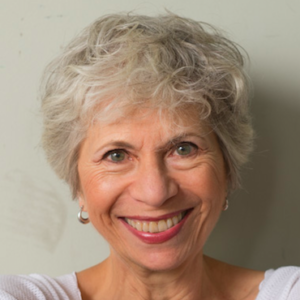Judith Sachs
 What is your primary artistic medium?
What is your primary artistic medium?
Adaptive Dance
How did you get started as a teaching artist?
After my first successful hip replacement I wanted to share my joy of movement with everyone, regardless of age or physical restrictions. I trained with the Dance for PD program and I am about to become one of their first certified teachers. Six years ago, I also started my own program, ANYONE CAN DANCE to further extend adaptive dance to those in wheelchairs, walkers, or elders who haven’t been moving in a while.
How does teaching inform your own artistic process?
My students teach me everything! I work on choreography based on what they like, the music that moves them most and the setting (solo or partnered work) that seems to click best with participants.
What led you to working in Creative Aging?
My own age and that of my contemporaries. I am 70 and I am constantly inspired by my peers artistic work. Whether it is in music, art, dance, writing, or theater.
Why do you think working with older adults is important?
Dr. Gene Cohen, the author of The Creative Age, proved that everyone has the ability and interest to be creative—at any age and with any physical or mental deviation from what we consider the “norm.” The unique combination of age, experience, and creativity can produce exciting inner growth and infinite potential. As I work with elders, I am constantly reminded that what seated dancers do is innovative and daring. And that the social engagement of my dancers keeps them committed to one another and to our practice.
What has been the biggest surprise in working with older adult learners?
That they will guide the work – you can’t be a “boss.” And that they will try practically anything you throw at them. I see how expansive the range of movement and dance can be, and how the architecture of a piece of choreography becomes more interesting with a more varied range of dancers. As older adults are recognized for their ingenuity, talent and daring, they can once again be considered leaders in the arts.
What skills are most important when working with older adults?
Patience and more patience. A sense of humor. A balance of challenge and fun in the classroom or rehearsal studio.
What have been your biggest challenges? How do you respond?
Death and increasing disability of my dancers. We talk about death in class and grieve together, but it is still my job to make sure everyone else is fine at the end of our time together. We don’t talk about how anyone’s disease is progressing… it’s just apparent and means that I constantly need to come up with more adaptive techniques.
What advice would you give someone that wants to do this work?
Do it! But make sure you have some life experience of your own behind you.
Tell us a short story from one of your classes that demonstrates the benefits of creative aging for participants.
In our Dance for Parkinsons class, we worked on an improv about flow with 3 groups of dancers –one seated and 2 moving. The idea was that one moving group wanted to get to the seated group and the other moving group had to prevent them from doing so. I asked a man who had difficulty moving forward on his own to lead the first group. He had to keep the others in formation and plow through the distractors.
When we debriefed afterward, the leader said he was surprised at how much responsibility it was to get others—not just himself—across the floor. And the seated people (who often considered themselves less able than the standing dancers in class) were really pleased to be the goal!
What are your current and upcoming projects of both your own work and teaching assignments?
I was recently featured on a segment for “Seeking Solutions for Suzanne,” on the Comcast Network.
I am currently working on a project called CLOSE CONTACT FOR COUPLES, an exploration of movement and verbal communication between couples. I am hoping to implement this through an academic study via workshops at the Ralston Gerontology Center in Philadelphia and OHSU in Portland, OR.
I am also working on a fall prevention program at several residences where I teach dance and hope to get more elders on the floor to explore unconventional ways of moving.
Thank you Judith for your wonderful work with Lifetime Arts.
To contact Judith check out her Teaching Artist Profile on Lifetime Arts’ Roster.
Search the Roster to find qualified Teaching Artists in your area.
Check back each month where we will feature a new Teaching Artist who has excelled in their work with the Creative Aging process.
Roster Artist Happenings
Elizabeth Anker
Performance (Jamaica Plains, MA)
Lisa Sparagen
Performance (New York, NY)
Cheryl Thomas
Workshop (Jamaica, NY)
Alacia Stubbs
Class (New York, NY)
Joan Green
Open Studios (Somerville, MA)
Sandor Schuman
Performance (Albany, NY)
Performance (Schenectady, NY)
Robin Brady
Performance (New York, NY)
Linda Luisi
Creativity & Nature Retreat (Costa Rica)
Susan Bendix
Workshop (Tempe, AZ)
Karen Fitzgerald
Exhibition (Hamilton, NY)
Art Fair (Brooklyn, NY)
Will Clipman
Concert (Verde Valley, AZ)

